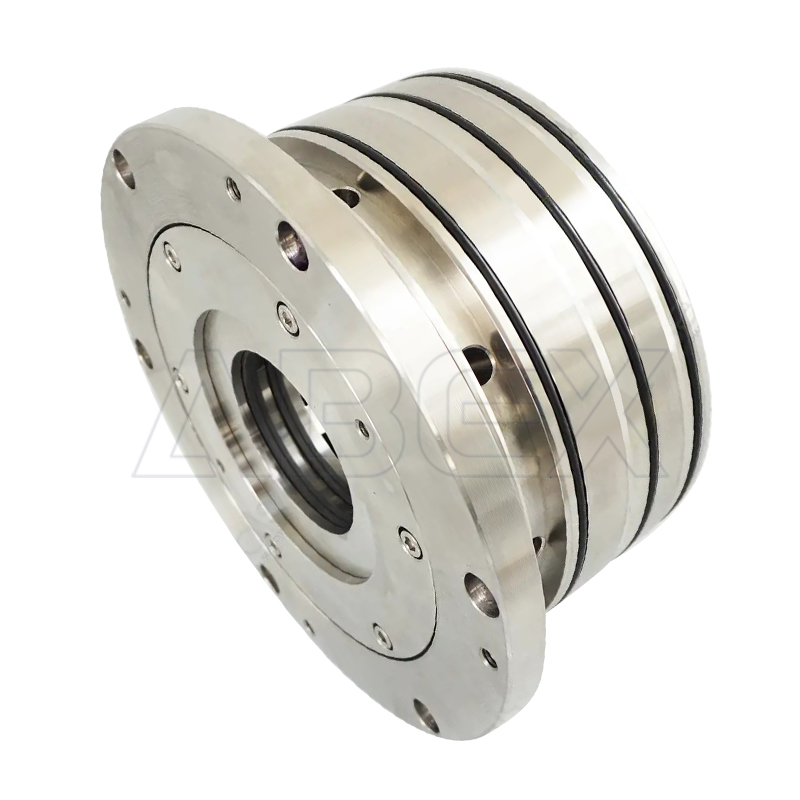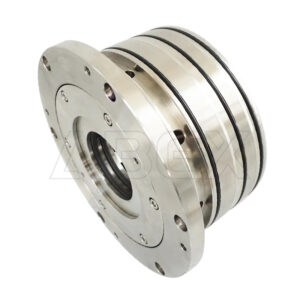This is Customized Dry Gas Seal for Compressors.
Dry Gas Seal (DGS) is a non-contact mechanical sealing technology used in rotating machinery (e.g., centrifugal compressors, turbines). Its core principle relies on the gas dynamic pressure effect to form a micron-level gas film, enabling sealing functionality while avoiding friction and wear. Below is a detailed explanation of its working principle:
1. Basic Structure
The dry gas seal primarily consists of two key components:
- Rotating Ring: Rotates with the shaft, featuring precisely machined spiral grooves (typically at micron-level depth) on its surface.
- Stationary Ring: Fixed in the seal housing, forming the sealing interface with the rotating ring.
2. Working Principle
(1) Dynamic Pressure Effect of Spiral Grooves
When the shaft rotates, the spiral grooves on the rotating ring drive the sealing gas (e.g., nitrogen, air, or process gas) to flow along the grooves.
The geometric design of the grooves (e.g., depth, angle, quantity) compresses the gas at the groove roots, generating a dynamic pressure effect (similar to an air cushion). This forms an extremely thin, stable gas film (typically 3–5 μm) between the rotating and stationary rings.
(2) Non-Contact Sealing
The gas film maintains a micron-level gap between the rotating and stationary rings, preventing direct contact and eliminating friction and wear.
The gas film pressure balances with the sealed medium pressure, preventing process gas leakage while blocking external contaminants from entering the equipment.
(3) Leakage Control
A minimal amount of gas (referred to as “buffer gas” or “barrier gas”) leaks from the high-pressure side (process side) to the low-pressure side (atmospheric side). However, the leakage rate is extremely low (typically less than 1 Nm³/h), meeting environmental and safety requirements.
3. Key Features
- Lubrication-Free: No liquid lubricant required, avoiding contamination of the process medium.
- Long Service Life: Non-contact design minimizes wear, with a lifespan of up to tens of thousands of hours.
- High-Speed Adaptability: Suitable for high-speed rotating equipment (linear speeds exceeding 200 m/s).
- High Temperature/Pressure Resistance: Capable of operating under high temperatures (above 300°C) and high pressures (exceeding 10 MPa).
4. Application Fields
Dry gas seals are widely used in:
- Centrifugal compressors (natural gas, petrochemical industries)
- Turbine expanders
- High-speed pumps
- Reactor agitator shaft sealing
5. Comparison with Traditional Seals
- Traditional Contact Seals: Rely on frictional contact, require lubricating oil, are prone to wear, and have a short lifespan.
- Sellos de gas seco: Utilize a gas film for non-contact sealing, eliminate wear, reduce maintenance costs, and ensure high reliability.
6. Summary
Dry gas seals achieve non-contact sealing through the dynamic pressure gas film generated by spiral grooves. They combine high efficiency, long service life, and environmental benefits, making them a key technology in modern high-speed rotating equipment. The core of their performance lies in the precision-machined spiral groove design and the ingenious application of gas dynamics.


